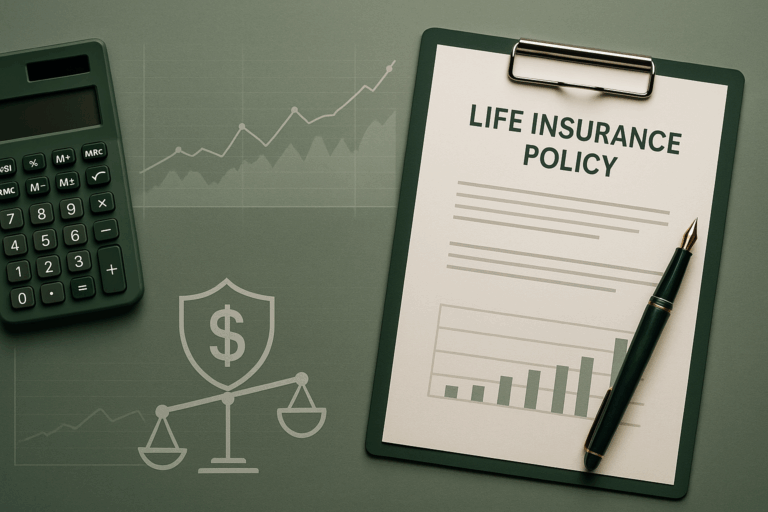Is Life Insurance a Waste of Money? 2025 CFO Guide
Author: Hotaling Team — licensed insurance advisors specializing in risk management for individuals, families, and businesses nationwide.
Life insurance isn’t inherently a waste—but neither is it always efficient. Executives benchmark its IRR, model premiums versus payouts, weigh insurer solvency (e.g., A++, AAA carriers), and build exit strategies before committing capital long-term. Life insurance can be a capital-efficient hedge or a drag. The answer depends on IRR under different scenarios, inflation-adjusted benefits, carrier track record, and opportunity cost compared to other asset classes.
From a CFO’s perspective, this isn’t an emotional decision — it’s a capital allocation exercise. You’re weighing:
-
Risk transfer value (death benefit)
-
Cost of capital (premiums)
-
Counterparty risk (insurer solvency)
-
Liquidity impact over decades
Key Takeaways
- Life insurance can be a capital-efficient risk hedge when priced properly and backed by solvent carriers.
- 20-year, $1M term insurance for a healthy 40-year-old costs roughly $60/month—about $720/year.
- Premiums should be evaluated for opportunity cost via IRR vs. alternative investments.
- Choose carriers with A++ AM Best/S&P/Fitch ratings, like New York Life or State Farm.
- Plan exit routes: surrender, convert, or pursue life settlements when financial conditions shift.
- IRR varies sharply by age, health class, and term length — scenario modeling is essential.
- Inflation erodes nominal payouts; a $1M benefit in 20 years may be worth just $553K (3% inflation).
- Whole life liquidity is limited in early years; cash value often lags cumulative premiums for 7–10 years.
- Carrier ratings today are important — but so is their 20-year track record of stability.
- Life insurance’s capital efficiency should be benchmarked against bonds, equities, T-bills, and private equity.
Costs
Sensitivity Analysis — Term Life IRR Scenarios
| Profile | Term Length | Annual Premium | Death Benefit | IRR if Payout Year 1 | IRR if Payout Final Year |
|---|---|---|---|---|---|
| 30yo, Preferred Plus | 20 yrs | $840 | $1,000,000 | 119,000% | 6,520% |
| 40yo, Standard | 20 yrs | $1,086 | $1,000,000 | 91,990% | 4,504% |
| 50yo, Preferred | 20 yrs | $2,340 | $1,000,000 | 42,689% | 2,055% |
| 60yo, Standard | 10 yrs | $4,800 | $500,000 | 10,308% | 846% |
Inflation-Adjusted Payout Values
| Nominal Payout | Term | Inflation Rate | Real Value at Term End |
|---|---|---|---|
| $1,000,000 | 20 yrs | 3% | $553,675 |
| $1,000,000 | 20 yrs | 5% | $377,107 |
| $500,000 | 10 yrs | 3% | $372,000 |
| $500,000 | 10 yrs | 5% | $306,000 |
Whole Life Liquidity Curve — $1M Policy
| Policy Year | Premium Outflow (Cum) | Cash Value | Liquidity Ratio |
|---|---|---|---|
| 1 | $16,464 | $0 | 0% |
| 5 | $82,320 | $54,000 | 65% |
| 10 | $164,640 | $146,000 | 89% |
| 15 | $246,960 | $260,000 | 105% |
| 20 | $329,280 | $405,000 | 123% |
Observation: In most cases, cash value doesn’t exceed premiums paid until years 12–15.
Capital Cost Comparison
| Asset Class | Long-Term Annual Return | Risk Profile |
|---|---|---|
| S&P 500 | 7% | Market risk |
| Corporate Bonds | 4–5% | Interest rate & credit risk |
| T-Bills | 2–3% | Inflation risk |
| Private Equity | 10–12% | Illiquidity & execution risk |
| Term Life IRR* | 4,500–119,000% (if payout) | Mortality timing risk |
IRR contingent on claim event.
Carrier Stability — 20-Year Track Record
| Carrier | 2000 Rating | 2008 Rating | 2025 Rating |
|---|---|---|---|
| New York Life | A++ | A++ | A++ |
| Northwestern Mutual | A++ | A++ | A++ |
| MassMutual | A++ | A++ | A++ |
| State Farm | A++ | A++ | A++ |
Source: AM Best, Moody’s, S&P archives.
How To Cancel Life Insurance Policy
1) Cash Surrender (walk away with cash value)
What it is: Cancel a permanent policy and receive the cash surrender value (CSV), net of any surrender charges and outstanding loans/interest.
When it makes sense
-
You no longer need the death benefit and want immediate liquidity.
-
Policy underperforms and you don’t plan to replace it.
-
You want to redeploy capital—and taxes on gain are acceptable (or manageable via planning).
What you get (and how it’s taxed in the U.S.)
-
Proceeds: CSV − surrender charges − loan payoff/interest.
-
Taxable gain (ordinary income):
Taxable amount = Proceeds − Cost basis
(Cost basis ≈ total premiums paid, adjusted for certain dividends/withdrawals.) -
If loans are outstanding, loan extinguishment at surrender can create taxable income even if little cash is received (“phantom income”).
-
You’ll typically receive a 1099-R for any taxable portion.
Steps & timeline
-
Request in-force illustration + cost basis + surrender charge schedule from the carrier.
-
Model tax impact and alternatives (1035 exchange, below).
-
Submit surrender form; typical funding 5–15 business days after approval (varies).
-
Confirm state withholding preferences and beneficiary notifications.
Pitfalls
-
Loss of coverage (future insurance may be pricier or unavailable).
-
Early-duration policies may have steep surrender charges.
-
Loans can trigger unexpected taxes.
-
If you plan to replace coverage, consider 1035 exchange first.
CFO tip: Before surrendering, compare after-tax proceeds to a Section 1035 exchange into a new life policy or annuity to defer current tax on gains.
2) Conversion (term → permanent, no new underwriting)
What it is: Exchange some/all of a term policy for a permanent policy (WL/UL/IUL/VUL) without evidence of insurability.
When it makes sense
-
Health has worsened; buying new coverage would be costly or declined.
-
Long-term needs emerge (estate liquidity, supplemental retirement income, special-needs planning, buy-sell).
-
You want to lock in coverage beyond the level-term period.
Key mechanics
-
No medical exam/underwriting.
-
Window: Often up to a specified age or until end of level term (carrier-specific—check your policy).
-
Face amount: You may convert all or a portion.
-
Conversion credit: Many carriers apply part of the current term premium to the first-year permanent premium.
-
Contestability/suicide period: Frequently carry the original issue date on conversion (verify carrier forms).
Costs & design choices
-
Premiums increase (permanent insurance).
-
Choose chassis: WL/UL/IUL/VUL depending on guarantees, funding flexibility, and market exposure.
-
Avoid inadvertently creating a MEC (Modified Endowment Contract) unless you want MEC treatment; coordinate premiums vs. 7-pay test.
Steps & timeline
-
Request conversion options and illustrations (different chassis, funding patterns).
-
Decide coverage amount/riders; coordinate overlap so term doesn’t lapse before conversion is placed.
-
Execute conversion forms; policies are often issued in weeks, not months.
Pitfalls
-
Converting too late (window closed).
-
Over-funding unintentionally triggers MEC.
-
Choosing the wrong chassis for your objectives (e.g., guarantees vs. accumulation).
CFO tip: Run side-by-side IRR on death benefit and, if relevant, cash value under prudent crediting assumptions vs. alternative capital uses.
3) Life Settlement (sell policy for cash)
What it is: Sell an in-force life insurance policy to a licensed settlement provider for a lump sum greater than CSV but less than the death benefit. The buyer becomes owner/beneficiary, pays future premiums, and collects the death benefit.
Typical eligibility (rules vary)
-
Often age 65+ or any age with material health impairment.
-
Face amount commonly ≥ $100k.
-
Policy types: UL, WL, some term (if convertible), and others.
When it makes sense
-
Premiums are burdensome, needs have changed, or an offer materially exceeds CSV.
-
No desire to keep, convert, or exchange the policy.
-
Liquidity now is more valuable than the contingent death benefit.
How proceeds are taxed (high-level U.S. view)
-
Amount up to cost basis: typically tax-free return of basis.
-
Above basis up to CSV: generally ordinary income.
-
Excess over CSV: generally capital gain.
(Tax treatment is nuanced—coordinate with a CPA.)
Process, timing, economics
-
Engage a licensed life settlement broker (to run a competitive auction) or go direct to a provider.
-
Provide policy docs, in-force illustration, cost basis, and medical records (HIPAA authorization).
-
Receive indicative bids → formal offers → escrow → ownership/beneficiary change → funding.
-
Timeline: commonly 6–12+ weeks.
-
Fees/commissions: Broker-mediated sales can carry meaningful commissions; vet disclosures and net proceeds.
Risks & considerations
-
Privacy/ongoing contact: You (or your physician) may be contacted periodically for health status updates.
-
Impact on benefits/creditors/estate plans: Coordinate with advisors.
-
STOLI rules & state regulation: Ensure all parties are properly licensed; observe contestability/two-year requirements in many states.
-
If terminal/chronically ill, explore accelerated death benefits/viaticals (often better tax treatment).
CFO tip: Run a three-way compare: (a) surrender after-tax, (b) convert (NPV of premiums vs. benefit), (c) settlement net of fees/taxes. Pick the highest-utility outcome for your capital plan.
Quick Decision Frame (cheat sheet)
-
Need cash now & policy underperforms? Model Surrender vs. Settlement (after-tax, after-fees).
-
Health declined but want to keep coverage? Convert within the carrier’s window.
-
Policy no longer fits, but market will pay more than CSV? Pursue Life Settlement via competitive bids.
Always coordinate with your tax advisor and have the carrier provide: in-force illustration, cost basis, surrender schedule, loan ledger, conversion options, and any MEC testing.
FAQs
At what point is life insurance not worth it?
When premiums exceed your projected IRR from other uses, or the carrier’s solvency is questionable.
How much does a $1,000,000 life insurance policy cost per month?
Between $60–$100/month for a healthy 40-year-old on a 20-year term.
What does Dave Ramsey say about life insurance?
He recommends term over whole, calling whole life a poor investment.
Is it worth having life insurance?
Yes, if it aligns with your capital allocation and risk-transfer strategy.
Can I sell my life insurance policy?
Yes, via life settlements, which offer a liquidity path beyond surrender.
Conclusion
Life insurance isn’t inherently good or bad—it’s about capital allocation and risk transfer. For executives, the key is modeling IRR, checking solvency, and having an exit strategy.


